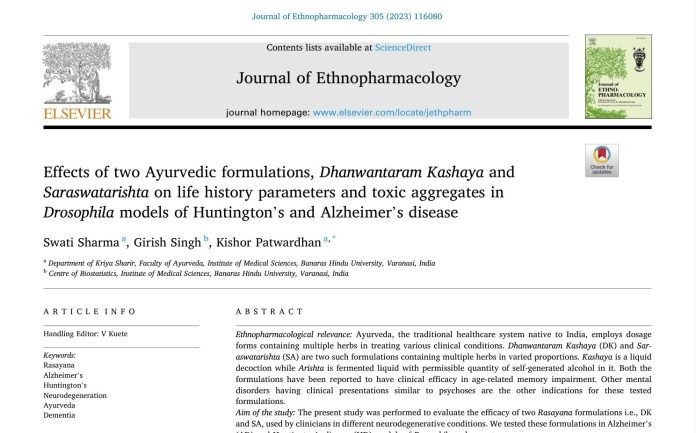Effects of two Ayurvedic formulations, Dhanwantaram Kashaya and Saraswatarishta on life history parameters and toxic aggregates in Drosophila models of Huntington’s and Alzheimer’s disease
Abstract
Ethnopharmacological relevance
Ayurveda, the traditional healthcare system native to India, employs dosage forms containing multiple herbs in treating various clinical conditions. Dhanwantaram Kashaya (DK) and Saraswatarishta (SA) are two such formulations containing multiple herbs in varied proportions. Kashaya is a liquid decoction while Arishta is fermented liquid with permissible quantity of self-generated alcohol in it. Both the formulations have been reported to have clinical efficacy in age-related memory impairment. Other mental disorders having clinical presentations similar to psychoses are the other indications for these tested formulations.
Aim of the study
The present study was performed to evaluate the efficacy of two Rasayana formulations i.e., DK and SA, used by clinicians in different neurodegenerative conditions. We tested these formulations in Alzheimer’s (AD) and Huntington’s disease (HD) models of Drosophila melanogaster.
Materials and method
Initial experiments looking for life-history parameters in wild-type larvae were carried out in three sets with hundred larvae in each set. These parameters were also studied in diseased models in four sets with eighty larvae in each set. Aβ plaques and polyQ aggregates were looked at with the help of immunostaining technique and images were captured using confocal microscopy.
Results
The results revealed that 0.25% concentration of both the formulations improve longevity in wild-type flies. Larval development and adult lifespan in Eye-GAL4>Aβ42 (AD) and GMR-GAL4>127Q (HD) larvae/flies reared on 0.25% & 0.50% DK and 0.25% & 1.00% SA improved substantially. Reduced Aβ plaques and polyQ aggregates indicate disease suppression.
Conclusion
DK and SA enhanced longevity in Drosophila melanogaster. Suppression of disease aggregates suggests their potential utility in treating AD and HD. Further clinical and pharmaceutical studies are required to confirm these results, however, this is a workable model to test multi-herbal formulations of Ayurveda in the forms they are clinically used.
The full paper can be accessed at: Effects of two Ayurvedic formulations, Dhanwantaram Kashaya and Saraswatarishta on life history parameters and toxic aggregates in Drosophila models of Huntington’s and Alzheimer’s disease





